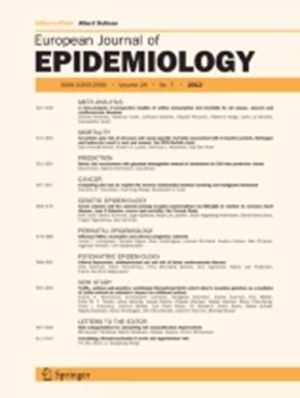基于人群的妊娠期药物安全性评估队列(PREGVAL):基本原理、设计和基线特征。
IF 5.9
1区 医学
Q1 PUBLIC, ENVIRONMENTAL & OCCUPATIONAL HEALTH
引用次数: 0
摘要
PREGVAL队列的主要目的是评估和监测给予孕妇的药物在子宫内的安全性,因为通常这一人群被排除在评估药物的临床试验之外。这是一个以人口为基础的队列,由2009年7月1日至2021年12月31日期间瓦伦西亚地区的孕妇及其后代组成,将从孕前6个月开始跟踪调查,直到死亡、失去保险或研究结束,在研究期间有52万多例怀孕。数据来源将是瓦伦西亚综合数据库(VID),该数据库使用唯一的个人识别码将个人层面的记录与有关合并症(糖尿病、高血压等)和其他临床变量、社会人口统计学变量(年龄、社会经济地位、社会排斥风险)以及其他潜在混杂因素(吸烟、饮酒)的详尽数据联系起来。它还提供了该地区发生的大多数活产和所有死产的接触时间的准确数据,以及部分自然流产和选择性终止妊娠的数据(由于这些结果可通过超声波获得胎龄或最后月经期,从而可以计算受孕日期),并可以非常详细地确定药物处方和配发数据。避免许多现有登记/队列中存在的潜在暴露错误分类问题。关于结果,有关于妊娠并发症、自然流产、终止妊娠(在这种情况下,是在公共卫生系统内发生的)、出生体重、早产、先天性异常和围产期死亡率的详尽和准确的数据;以及产后长期随访的可用性。这些特点使PREGVAL研究成为迄今为止评估药物在真实子宫内安全性的最大和最详尽的队列之一。本文章由计算机程序翻译,如有差异,请以英文原文为准。
A population-based cohort to evaluate drug safety during pregnancy (PREGVAL): rationale, design, and baseline characteristics.
The main aim of the PREGVAL cohort is to evaluate and monitor the in-utero safety of medication administered to pregnant women, as usually this population is excluded from clinical trials assessing drugs. It is a population-based cohort, comprised by pregnant women and their offspring in the Valencia Region (Spain), between July 1st 2009 and December 31st 2021, which will be followed from 6 months pre-conception until death, loss of coverage or end of study, with over 520.000 pregnancies for the study period. The data source will be the Valencia Integrated Database (VID), which links records at the individual level using a unique personal identification code, with exhaustive data on comorbidities (diabetes, hypertension, etc.) and other clinical variables, sociodemographic variables (age, socio-economic status, risk of social exclusion) and other potential confounders (smoking, alcohol intake). It also provides accurate data on timing of exposure for most livebirths and all of the stillbirths occurred in the region, and partially for spontaneous abortions and elective terminations (due to the availability of gestational age by ultrasound or last menstrual period for these outcomes allowing the calculation of the date of conception) and allows the identification of medications prescription and dispensation data with a very high detail, avoiding the problem of potential exposure misclassification present in many of the existent registries/cohorts. Regarding outcomes, there is exhaustive and accurate data on pregnancy complications, spontaneous abortions, terminations (in this case, those occurred within the public health system), birth weight, preterm birth, congenital anomalies, and perinatal mortality; as well as the availability of post-natal long-term follow-up. These features make the PREGVAL study one of the largest and most exhaustive cohorts to assess real-world in-utero safety of medications to date.
求助全文
通过发布文献求助,成功后即可免费获取论文全文。
去求助
来源期刊

European Journal of Epidemiology
医学-公共卫生、环境卫生与职业卫生
CiteScore
21.40
自引率
1.50%
发文量
109
审稿时长
6-12 weeks
期刊介绍:
The European Journal of Epidemiology, established in 1985, is a peer-reviewed publication that provides a platform for discussions on epidemiology in its broadest sense. It covers various aspects of epidemiologic research and statistical methods. The journal facilitates communication between researchers, educators, and practitioners in epidemiology, including those in clinical and community medicine. Contributions from diverse fields such as public health, preventive medicine, clinical medicine, health economics, and computational biology and data science, in relation to health and disease, are encouraged. While accepting submissions from all over the world, the journal particularly emphasizes European topics relevant to epidemiology. The published articles consist of empirical research findings, developments in methodology, and opinion pieces.
 求助内容:
求助内容: 应助结果提醒方式:
应助结果提醒方式:


